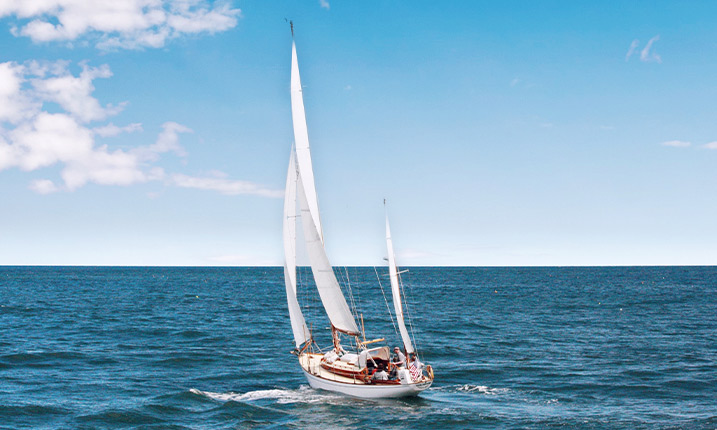
Sailing is a rewarding hobby enjoyed by millions of people all over the world. It's not necessarily easy to learn, but an amateur can master the basics in a relatively short period of time. With a little bit of experience, and a strong wind pushing you along, you should have no trouble piloting a boat through the open water and enjoying your time outdoors.
But what happens when that wind fizzles out? What if you get trapped in an area with little to no wind? Are you going to get stranded, or is there a way that you can sail despite the low wind availability?
The Low Wind Problem
With a strong wind at your back, it's much easier and more straightforward to sail. But sailing in low winds, without much force to drive you, is much more complicated. Note that the term here is complicated, not impossible.
Most of the time, there's at least some wind present, even if it doesn't feel like the air is moving around you. And as long as you have a little bit of wind, there's the possibility that you can manoeuvre your way out of this situation.
What Are the Doldrums?
“The doldrums” is a nautical term that refers to a circle around the Earth close to the equator. Sometimes referred to formally as the Inter-Tropical Convergence Zone (ITCZ), this belt spans between five degrees north and five degrees south of the equator. Here, you’ll notice there’s very little, if any wind.
But why does this happen? The short answer is because of the sun. The sun hits the equator directly and reliably, which is why land masses near the equator tend to be hotter. Because the sun is constantly heating this area, warm air is sent up through the atmosphere, where it cools and causes rain showers and storms. Eventually, the cooling air reaches the so-called “horse-latitudes,” where it then slowly migrates back to the surface of the planet.
The upward trajectory of this warm air and its eventual resettling away from the equator is responsible for the doldrums – but the doldrums aren’t the only area where you’ll occasionally find a near-total lack of wind.
How to Sail in Low Wind
If you're stuck in the doldrums, or if you're in the middle of a period of little to no wind, there are several things you can do to sail anyway.
- Improve your understanding of wind conditions. First, it's important to understand wind conditions and how winds form. We've gone over some of the details of how wind is formed in the previous section, so we won't repeat ourselves here. Your takeaways should be that wind tends to form when warm air and cold air interact in the atmosphere; if you know that there's a warm front or a cold front on its way, you may be able to anticipate changes in wind patterns and adjust your course accordingly.
As an added sidenote, it's important to watch the weather carefully before heading out on your sailboat. If there's a chance the wind will die down, or if there's not much wind to start with, you may want to pick a different day to sail.
- Watch tide tables (and use the tide to your advantage). It's also a good idea to watch tide tables and better understand how the inflow of tide works around you. When tides change, they're responsible for the formation of tidal currents, which can change the flow and speed of the water underneath you. This won't be enough to match your speed when taking advantage of a high burst of wind, but it could be enough to complement your efforts in the low wind conditions.
- Keep an eye out for catspaws. Catspaws are localised patches of ripples on the water, often caused by occasional breezes passing by. If you're studious, and you're willing to adapt to these spontaneous circumstances, you may be able to take advantage of short bursts of breeze.
- Use lighter sheets for more manoeuvrability. Consider rolling out lighter sheets for more manoeuvrability. When there isn't much wind to work with, your resources are extremely limited period every decision you make is going to count, and every inch forward is going to be valuable. You can't count on making a major mistake or losing control of the sailboat, so a lighter she could be the perfect fit for this situation.
- Try to reduce drag. As much as possible, try to reduce drag on your boat and make it as aerodynamic as possible. This way, you'll decrease potential wind resistance and improve the efficiency of your boat moving forward. In other words, this will allow you to take full advantage of any wind you can find, rather than losing potential energy to avoidable drag.
- Heel the boat. Heeling allows you to take advantages of an aerofoil shape, which is much better at taking advantage of short and weak gusts of wind.
- Slacken everything (for the most part). As a rule of thumb, slacken everything in the face of weak wind. Just be careful not to overdo it; if you take this advice too far, you won’t be able to capitalise on the bits of wind you do experience in your travels.
- Know when to call for help. Finally, make sure you have plenty of emergency supplies on board, including a radio and backup batteries so you can call for help when necessary. With experience and knowledge, you should be able to navigate your way out of a low wind situation, but in a worst case scenario, it pays to be prepared.
Sailing is much easier – and much more fun – when you have the right vessel to control. And if you’re in the market for a new sailboat, TheYachtMarket is the perfect place for you! Browse our selection of new and used boats for sale today!